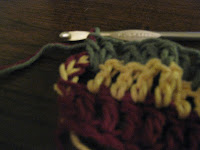 After mapping out several patterns, and making several dishcloths, I came up with this three color pattern. A variation of the Half and Half striping pattern is to use two separate strands for one of the colors. This generates a look of two rows of the main color flanked on either side by a single row of a color, which varies between two colors.
After mapping out several patterns, and making several dishcloths, I came up with this three color pattern. A variation of the Half and Half striping pattern is to use two separate strands for one of the colors. This generates a look of two rows of the main color flanked on either side by a single row of a color, which varies between two colors. Here's how to do this:
Make your chain and work one row with color B. At the end of the row, tie on color C, do not cut color B. Finish the stitch by pulling both strands together through the loops. Chain with both strands.
Release color B, and work row 2 with color C. At the end of the row, tie on color A, and pull both colors through the loops, then work 2 rows with color A, pulling color B up the side after the first row. For more detailed illustrations on how to do this, see my earlier striping posts.Here's the pattern:
Chain 28
Row 1: dc in 4th chain from hook, dc across
Row 2-14: ch 3, turn, dc across
Border:
Round 1: sc around (3 sc in corner)
Round 2: sc around (3 sc in corner)
Rows 3-4, 7-8, 11-12 are in the red color.
Rows 1, 6, 9, 14 are in the green color.
Rows 2, 5, 10, 13 are in the yellow color.
I made this using Sugar and Cream Sage Green, Country Yellow, and Wine with a J hook.






















































